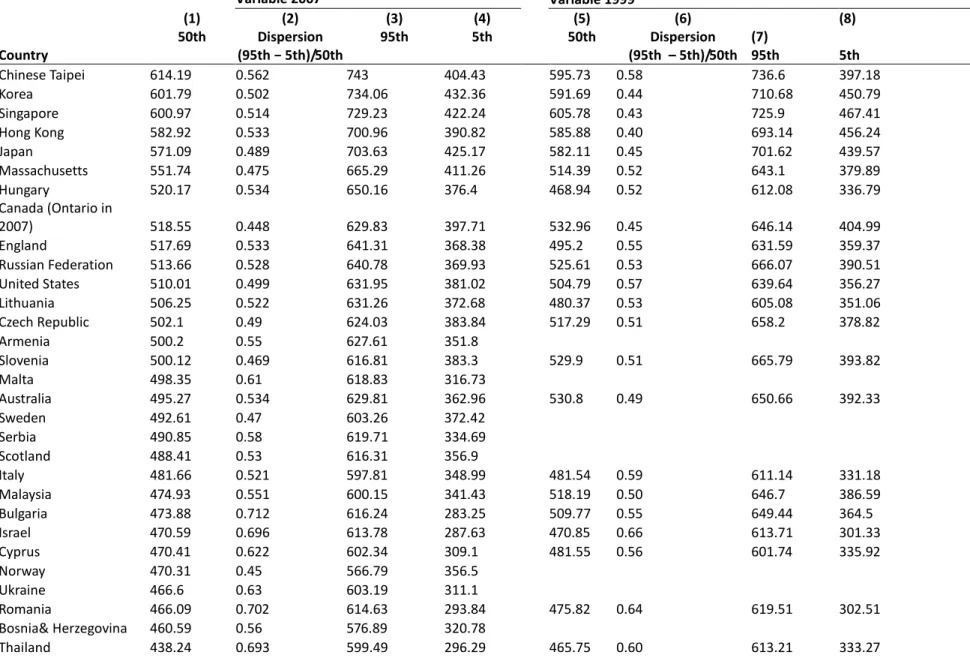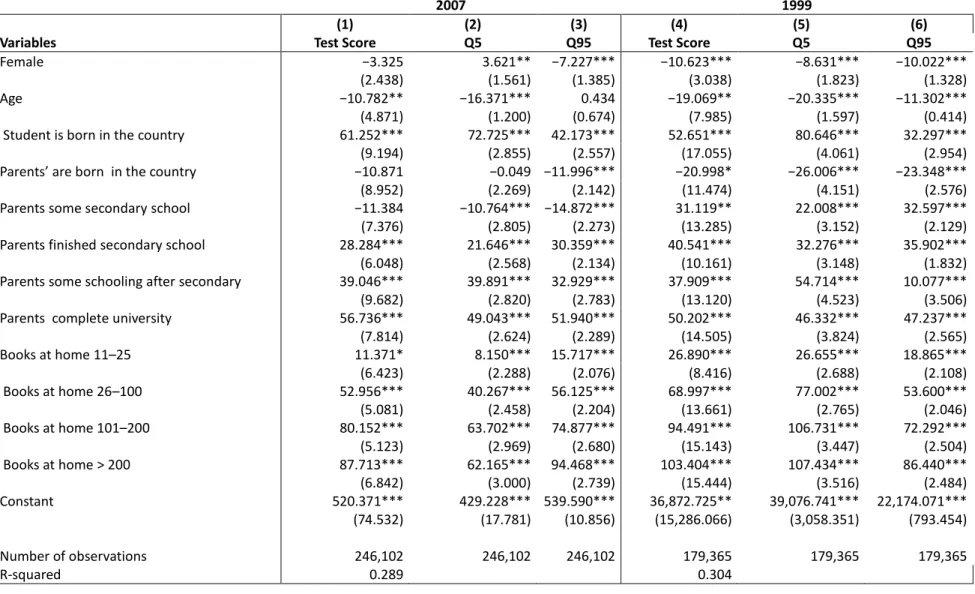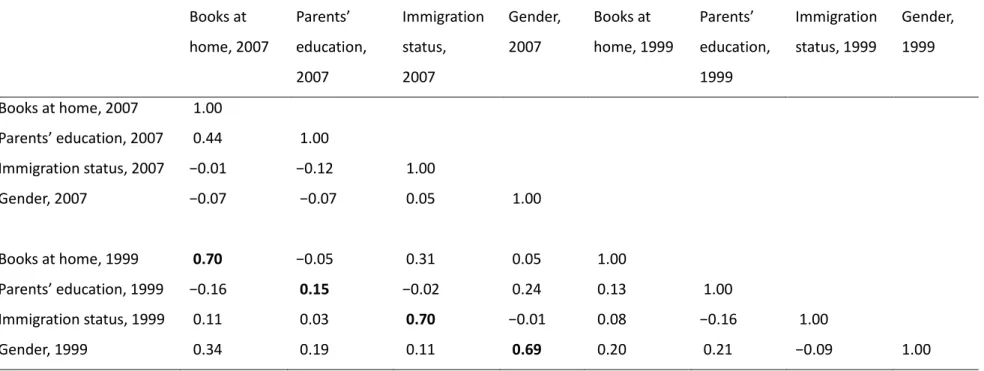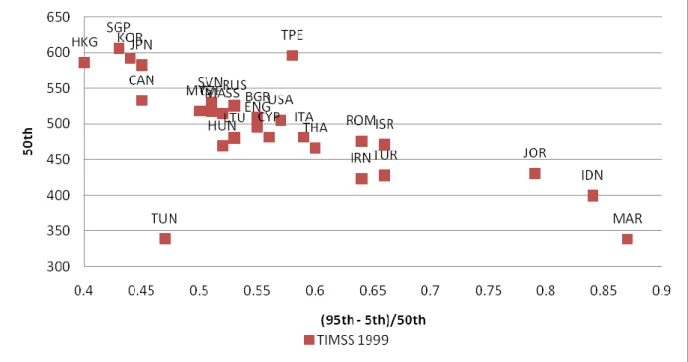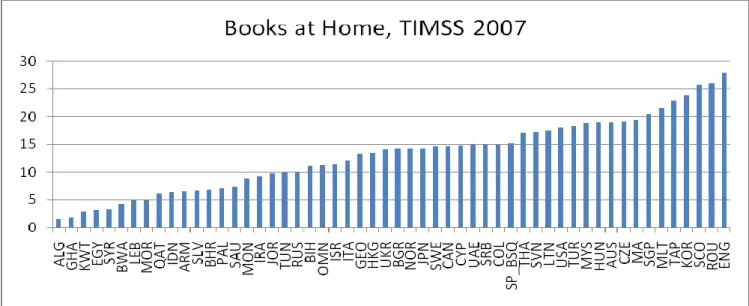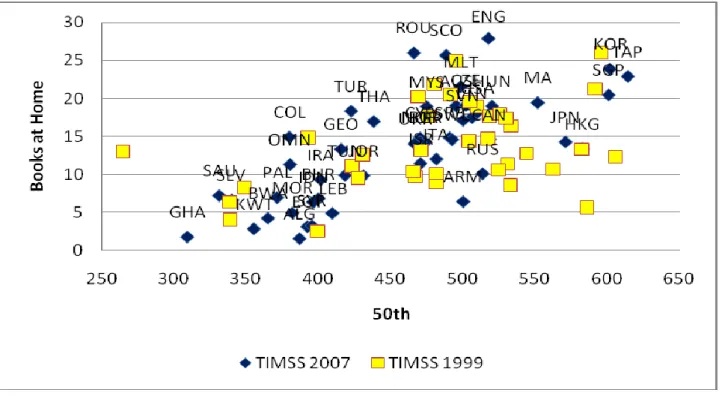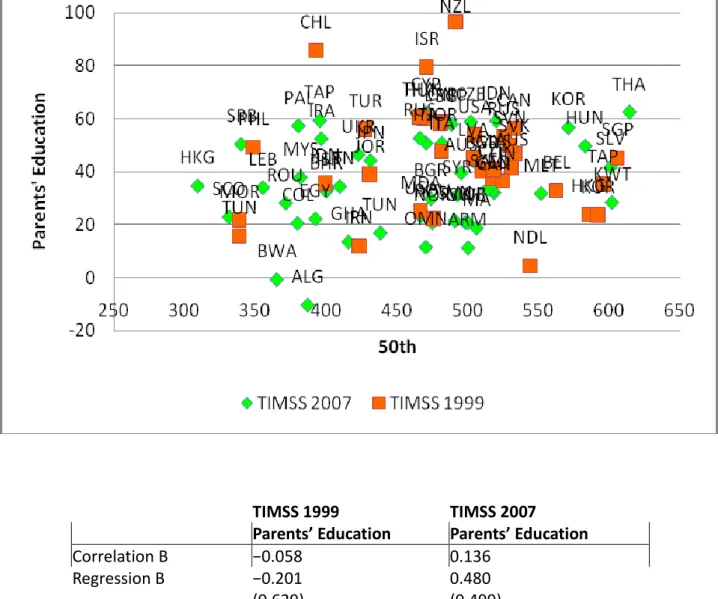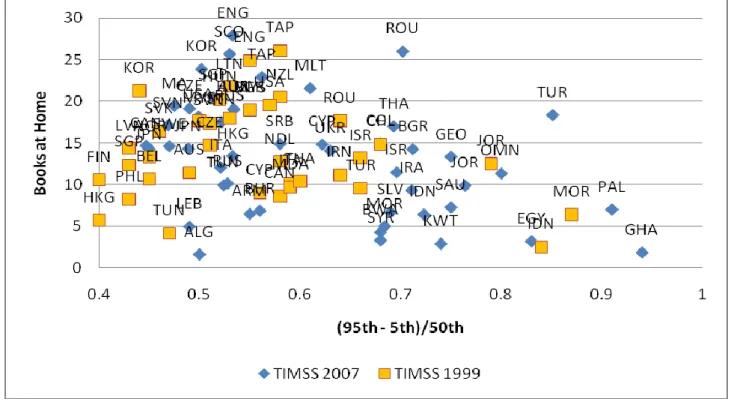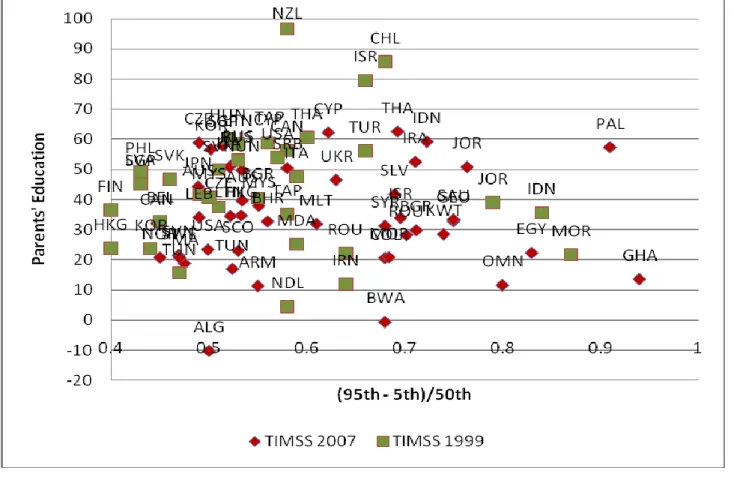CEE DP 117
Variation in Educational Outcomes and Policies across Countries and of Schools within Countries
Richard B. Freeman Stephen J. Machin Martina G. Viarengo
August 2010
ISSN 2045-6557
Published by
Centre for the Economics of Education London School of Economics
Houghton Street London WC2A 2AE
© R.B. Freeman, S.J. Machin and M. Viarengo, submitted July 2010
All rights reserved. No part of this publication may be reproduced, stored in a retrieval system or transmitted in any form or by any means without the prior permission in writing of the publisher nor be issued to the public or circulated in any form other than that in which it is published.
Requests for permission to reproduce any article or part of the Paper should be sent to the editor at the above address.
The Centre for the Economics of Education is an independent multidisciplinary research centre. All errors and omissions remain the authors.
Executive Summary
The motivation for this paper is to increase our understanding of the way in which inequality in educational outcomes and in the relation between measures of backgrounds is related to levels and dispersion of educational performance of young persons. The article thus sheds light on the international variation in the importance of socioeconomic status in affecting the quality of educational outcomes.
This paper uses test scores on eighth-grade mathematics from the 1999 and 2007 waves of the Trends in International Mathematics and Science Study (TIMSS) to examine the magnitude and correlates of country differences in levels and dispersion in test scores. It relates test scores of students to measures of their background characteristics within each country and examines the link between the estimated association of characteristics with the country level and dispersion of test scores. The evidence shows the following:
1. Wide cross-country variation in the level and dispersion of test scores, with a virtuous equity-efficiency relation in which higher test scores are associated with lower inequality in scores across countries.
2. Substantial variation among countries in the importance of measures of family background in predicting the mathematics test scores of eighth-grade students.
3. Higher median test scores and lower variation in student test scores in countries in which family background as measured by the number of books in the home is strongly related to test scores than in countries where it is weakly related to test scores, but no such patterns when family background is measured by parents’
educational attainments.
Variation in Educational Outcomes and Policies across Countries and of Schools within Countries
Richard B. Freeman Stephen J. Machin Martina G. Viarengo
1. Introduction and Motivation 1
2. Measures of Outcomes and Empirical Analysis 2
3. Conclusion 9
References 11
Tables 13
Figures 17
Appendix 26
Acknowledgments
Richard B. Freeman is the Ascherman Professor of Economics at Harvard University, Director of the Labor Studies Program at the National Bureau of Economic Research and a Senior Research Fellow at the Centre for Economic Performance, London School of Economics.
Stephen Machin is Director of the Centre for the Economics of Education, Director of Research at the Centre for Economic Performance, London School of Economics and a Professor at the Department of Economics, University College London. Martina Viarengo is a Research Officer at the Centre for Economic Performance at the London School of Economics, a Postdoctoral Fellow at the John F. Kennedy School of Government at Harvard University, and an Associate at the Centre for the Economics of Education.
1 Introduction and Motivation
Educational outcomes vary widely across countries and within countries. There are many possible reasons for this variation, ranging from the resources given to the educational system, the practices followed, differences in family backgrounds of students, and differences in learning resources outside of the formal educational system. Outcomes also vary greatly within countries, producing a wide dispersion of test scores among students. This paper uses test scores on eighth-grade mathematics from the 1999 and 2007 waves of the Trends in International Mathematics and Science Study (TIMSS) to examine the magnitude and correlates of country differences in levels and dispersion in test scores. It relates test scores of students to measures of their background characteristics within each country and examines the link between the estimated association of characteristics with the country level and dispersion of test scores. The evidence shows the following:
1. Wide cross-country variation in the level and dispersion of test scores, with a virtuous equity-efficiency relation in which higher test scores are associated with lower inequality in scores across countries.
2. Substantial variation among countries in the importance of measures of family background in predicting the mathematics test scores of eighth-grade students.
3. Higher median test scores and lower variation in student test scores in countries in which family background as measured by the number of books in the home is strongly related to test scores than in countries where it is weakly related to test scores, but no such patterns when family background is measured by parents’ educational attainments.
The motivation for this chapter is to increase our understanding of the way in which inequality in educational outcomes and in the relation between measures of backgrounds is related to levels and dispersion of educational performance of young persons. Higher scores on tests presumably contribute to economic prosperity due to the link between educational outcomes and future labor
income. Lower dispersion of test scores within a country presumably reduces future labor-market inequalities and enhances intergenerational mobility by reducing differences in skills associated with family backgrounds. Recent comparable international test scores reveal large variation in educational performance across countries, even when the focus is limited to countries with similar levels of economic development. , Test score comparisons also reveal large variations in equality in educational opportunities.
Understanding the effect of family background on students’ educational achievement is important, given that the family is one of the main agents in children’s development of their human capital.
Moreover, intergenerational mobility in education is closely related to intergenerational mobility in earnings. Following the existing literature (for example, Woessmann 2004, 2008; Schuetz, Ursprung, and Woessmann 2008), we document the effects of family background on students’
performance. We use an internationally comparable data set that includes a very large number of developed and developing countries and a sufficiently large number of students per country. This allows us to estimate country-specific associations between background and educational test scores. The chapter thus sheds light on the international variation in the importance of socioeconomic status in affecting the quality of educational outcomes.
2 Measures of Outcomes and Empirical Analysis
Since the early 1960s, the International Association for the Evaluation of Educational Achievement—an independent international cooperative of national research institutions and governmental research agencies,—has produced the Trends in International Mathematics and Science Study (TIMSS) international tests of mathematics and science achievement for fourth- and eighth-grade students.1 Representative of participating countries agreed on the curriculum covered by the TIMSS study to align the tests with what countries teach through those years. Each country
1 The analysis has been carried out also by using the Programme for International Student Assessment (PISA) study.
Results are available from the authors upon request.
samples schools with classes in the relevant grades and then samples classes within schools and students within the classes to obtain representative samples of students. TIMSS standardized the test scores to make the average score among participating countries equal to 500 and the standard deviation equal to 100 in 1995. The number of countries in the TIMSS increased from 40 participating countries in 1995 to 59 countries in 2007.2
To see how students fare across countries, we analyze scores on the international TIMSS tests of eighth-grade students in mathematics in 1999 and 2007. The survey sampled approximately 4,000 students in 150 schools in each country in each year, which gave us a sample of 246,102 eighth- grade students. While our analysis deals solely with the eighth-grade mathematics test, we also examined the science tests for eighth-graders and the mathematics and science test scores for fourth-grade students. We found similar patterns to those that we report here.3
Table 1 presents statistics on the test scores for each country that reported in either of 2007 or 1999. Columns 1 and 5 give the median score in each country in 2007 and 1999 under the year headings. Looking down the columns, we see that these scores vary substantially among countries.
Five Asian countries are at the top of the list, And in 2007 a set of Middle Eastern countries (Kuwait and Saudi Arabia) and El Salvador and Ghana are at the bottom are at the bottom. To quantify the variation in median scores among countries, we calculated the ratio of the score of the country in the 95th percentile minus the score of the 5th percentile country divided by the median. In 2007 this measure of variation was 0.58. In 1999 the measure was essentially the same: 0.59. Looking across the years, the table also shows considerable persistence in which countries are at the top and bottom of the scale: for countries reporting in both 1999 and 2007, the correlation between the median scores is 0.913.
2 TIMSS also included some benchmarking participants (which are states, regions, or provinces that participated in the study for their own benchmarking purposes): thirteen U.S. states and fourteen U.S. school districts in 1999; four regions/provinces from three countries in 2003; and seven regions/provinces and U.S. states in 2007.
3 The science scores for eighth grade are highly correlated with the math scores for that grade among students (0.82 in 1999 and 0.86 in 2007) and within-country averages (0.95 in 1999 and 0.93 in 2007), so that it would be strange indeed if the statistical analysis gave different results. Results for these other groups are available from the authors upon request.
Columns 2 and 6 give a measure of the dispersion of scores within countries—the score at the 95th percentile (columns 3 and 7) minus the score at the 5th percentile relative to the median. This measure of the dispersion of test scores across countries averages 0.62 in 2007, which is of a similar magnitude to the comparable measure of dispersion across countries reported above. The correlation over time in within-country inequality is, however, smaller than the correlation across countries at 0.744.
There is a striking inverse relation between the within-country dispersion of scores and the average level of scores by country in the table 1 data. Lower inequality in test scores is associated with higher average scores. To show this pattern graphically, figure 1a displays the median country score in the TIMSS and the 95th percentile minus the 5th percentile score relative to the median in 1999.
Figure 1b provides the comparable information for 2007. The negative relation between the two variables is statistically significant. This pattern is the opposite of the Okun-style equity-efficiency trade-off, in which inequality and performance are positively related. Instead, we find a virtuous link in which countries that raise the scores at the bottom of its distribution more than they raise scores at the top have higher medians.4
To what extent do the test scores of students vary by background characteristics and gender? Do background factors have similar or different effects on scores across countries?
To answer the first question, we estimated the following ordinary least-squares regression model for the two TIMSS waves:5
(1) Tics = α + βXics + cG + uics,
4 This result could depend on the metric used to assess tests. For example, a scoring method that valued high scores much more than low scores could yield different results. In this case, an improvement at the bottom of the distribution of test scores could have a lower impact in the improvement of the overall performance. If the sole goal of the country was to produce Math Olympiads, for instance, the only thing that would matter would be the very top scores and the country would weight at zero improvements at the bottom of the distribution.
5 Hanushek (2007) and Hanushek and Woessmann (2010b) provide a review of the education production functions estimated in the literature.
where Tics is the test score of student i, in class c and school s; Xics is a vector of family-background variables; and G is a 0/1 dummy for being female. Our measures of advantaged homes are the following: the presence of books at home, which is positively correlated with the socioeconomic status of the family (Beaton et al. 1996) and an important predictor of students’ performance (Woessmann 2003, 2004); dummy variables for the highest level of schooling by either of a student’s parents;6 and dummy variables for whether the student was an immigrant or native and whether the student’s parent was or was not an immigrant.
We estimate equation 1 for the entire population of students in the sample using ordinary least squares.7 Columns 1 and 4 in table 2 give the estimated coefficients on the relation of background factors to the test scores for the two years. In 2007 the coefficient on female is not statistically different from zero; that on being born in the country is positive significant; while the positive coefficients on the measures of books in the household and parental education show substantial advantages to a more privileged background on outcomes.8 To see whether family background affects students differently at different points in the conditional distribution of achievement, we also estimated equation 1 with quantile regressions. Columns 2 and 5 and columns 3 and 6 give the estimated coefficients for quantile regressions for persons at the 5th and 95th percentiles. If the effects of a variable that improves outcomes are greater at the 95th percentile than at the 5th percentile, that raises inequality, while the converse holds if the effects of a variable are greater at the 5th percentile than at the 95th percentile. Specifically, in both years the coefficient of books at home at both 5th and 95th percentiles is larger for higher levels of parents’ education and a greater number of books at home. Moreover, if we focus on the coefficient of parents’ university education and books at home (200 and above), the larger coefficient at the 95th than at the 5th percentile
6This dummy variable has been constructed from the variable available in TIMSS: “Parents’ highest education level”
(which takes the following categories: university degree; completed postsecondary education but not university;
completed upper-secondary education; completed lower-secondary education; less than lower-secondary education; do not know).
7 To address missing data and not to exclude observations, we estimated missing values by means of a multiple imputation technique in King et al. (2001): the multivariate imputation by chained equations (Van Buuren and Oudshoorn 1999, “MICE” method in STATA). This imputes missing variables from an iterative multivariable switching- regression technique. We created five imputed data sets and averaged regression coefficients over the five sets to estimate values for the missing independent variables.
8 Farkas (2010) shows how by middle school students from ethnic minorities and more disadvantaged backgrounds lag behind their higher-income counterparts in both learning and behavioral outcomes.
would suggest that an increase in these two variables has a larger impact on students at the high end of the distribution. Immigration status is more important for students at the low end of the distribution, whereas the number of books at home is more important for persons in the higher part of the distribution.
The most telling change in coefficients over time is on gender. In 1999, eighth-grade girls did significantly worse on the math exam than eighth-grade boys; but consistent with other studies that show women catching up with men in mathematical tests (Hyde et al. 2008; Nosek et al. 2009), the coefficient on gender turns insignificant in the 2007 data. The biggest gain for girls occurred in the lower parts of the test-score distribution, where quantile regressions show the coefficient on females switching sign from −8.6 to +3.6 between 1999 and 2007 in the 5th percentile. It declined less at the upper end of the test-score distribution. This pattern shows that the dispersion of test scores among women in the sample narrowed while the dispersion among men did not, contributing to the drop in the male advantage on the mathematical tests scores.10 In another chapter in this volume, Bailey and Dynarski (2011) document that inequality in educational attainment (in terms of college-entry and college-completion rates) between men and women has significantly increased during the last thirty years, with women outperforming men in every demographic group.
The TIMSS contains enough observations on students in each country to allow us to do something that is rare in analyses of social background effects: to estimate the relationship between background and outcomes for a large sample of countries using the same survey instrument. We divided the sample by country and estimated the equation in table 2 for all of the counties in the TIMSS surveys. These calculations show large cross-country variation in the effect of background on test scores. In some countries, background contributes greatly to the variation in scores, whereas in others it has modest effects. Figure 2a displays the estimated coefficients for books at home, parental education, gender, and immigrant status from the OLS regression of tests scores in 2007, and figure 2b illustrates the comparable information for 1999. What stands out in both years is the large variation in the estimated effects of the background factors on test scores, which range from
10 To see if this result is due to changes in the country composition of the samples between 1999 and 2007, we estimated the same equations for the twenty-six countries reporting in both years and obtained similar results.
negligible to huge for books at home (represented by the coefficient on the average number of books at home) and for parental education (represented by the coefficient on the dummy variable for parent having university education). Figures 2a and 2b also illustrate both the variation across countries in male-female differences in test scores and changes over time in the relative performances of females and males on the TIMSS mathematics test. In 1999, the average score of females was higher than that of males in only 4 countries out of the 36 covered in that year. In 2007 the comparable figures are 22 countries out of 50.
If countries have large or small estimated coefficients on all or most of the background factors that affect test scores, the results could be interpreted as reflecting some general latent factor that one might label as the societal difficulty or ease of transforming background resources into school performance. If, by contrast, countries had similar coefficients on the same background factor in 2007 and 1999 with only a weak correlation with other factors, the natural interpretation would be that each measure reflects stable but different channels by which background factors affect performance. To examine these two possibilities, we computed the correlations among the estimated background coefficients for countries reporting in both the 1999 and 2007 TIMSS surveys. The results in table 3 show that coefficients on particular background factors are highly correlated over time. For instance, the correlation across countries of the coefficient on books in the household in 1999 and the coefficient on books in the household in 2007 is 0.70. By contrast, there is a weak, often negligible correlation between the coefficients of the background variables across countries in the same year. On the basis of these correlations, the measures seem to reflect independent channels and thus should not be “forced” into a single latent variable model of background.
Given this finding, we ask next whether countries with larger or smaller coefficients on particular background factors have higher/lower average test scores or greater/lesser within-country inequality in scores. A priori it is not clear how larger background coefficients affect outcomes. On the one side, larger background coefficients might produce greater levels of inequality given that they reflect the ability of more advantaged homes to pass on their advantages to their children.
This in turn might be associated with lower average scores owing to the inverse relation between inequality and average scores shown in figures 1a and 1b. On the other side, large background coefficients could reflect the openness of society to parental investments in children that could
induce parents with fewer resources to invest more heavily in their children. Persons from disadvantaged groups whose parents obtained greater education or who had many books in their household would be more likely to help their children in a society where the coefficients on those factors are high compared with a society where the coefficients on those factors are low.
To determine whether the estimated impact of having books in the household affects the level of test scores across countries, figure 3a plots the estimated coefficients on books at home against the median test score for countries in the 2007 or 1999 samples. It shows a strong positive link between the estimated coefficient for the impact of books in the household on the level of test scores in a country. The regressions at the bottom of the figure show that the patterns are highly significant. The relation is stronger for 2007 than 1999 but significant in both years (see statistics in the note to the figure show). By contrast, the relationship between the estimated coefficient on parental university education and the median level of country test scores (figure 3b) shows a greater scattering of the data points. The correlation is slightly positive but small and statistically insignificant. Countries where parents with higher education give greater advantages to their children in test scores do only a modicum better than countries where parental background is weakly related to test-score performance.11
Figure 4a displays the relation between the estimated impact of having books in the household on test scores on the dispersion of test scores within a country. We again measure dispersion by the 95th percentile minus the 5th percentile relative to the median. The figure shows a moderate negative relation between the coefficients on having books in the household and the measure of inequality. The sizable coefficient on books in the household seems again more reflective of an open society that produces less inequality in test scores. Figure 4b shows a slight positive relation between the estimated impact of parental education on individual student test scores and the inequality of scores.
11 Hertz et al. (2007) use the regression coefficient of parents’ education as a predictor of schooling across generations and find a long-run decrease in this indicator of intergenerational educational inequality. By contrast, Hertz et al. (2007) find a constant correlation between parents’ and children education, at around 0.4, and parents’ education to be an important predictor of the cross-country variance of students’ achievement. Woessmann (2008) examined the effect of family background on students’ performance in seventeen western European countries and the United States by relying on TIMSS 1995 and finds that equality of opportunities is unrelated to countries’ mean performance.
In short, the results on books in the household show that greater impacts on test scores are associated with higher levels of scores and lower levels of dispersion, and thus contribute to the virtuous relation between them. On the contrary, the results using parental education as the background measure show less of an association with the country-level outcomes. This suggests a larger inequality impact of an income proxy such as books at home as compared to parents’
education.
Other chapters in this volume examine inequality of educational opportunity in the United States (for example, Hout and Janus; Reardon). Hout and Janus (2011) find that educational mobility has decreased since the 1970s in the United States mainly due to the slow growth in high school and graduation rates, leaving current students only slightly ahead of their parents in terms of graduation rates. We observe that in 2007, the United States is ranks lower with respect to the coefficient of books at home than in 1999 (figs. 2a and 2b). In the short period of time that separates the two TIMSS waves, we also observe that both the coefficient on parents’ education and the measure on inequality in achievement have decreased for the United States between (fig.
4b).
3 Conclusion
Cross-country analyses are notoriously problematic. Data often come from surveys that differ substantially in representativeness and quality. There is a diverse set of potential measures of country characteristics that researchers can use to explain country differences: language, geographic, ethnic composition, history, culture—more variables than countries, indeed. Many of the measures, moreover, are subject to potential misinterpretation without detailed knowledge of the country.12 This is particularly the case when countries with nominally identical policies implement policies more or less rigorously
12 For example, France has a very low unionization rate, which suggests that unions have little impact on labor-market outcomes, when in fact France’s labor regulations give unions a large impact through collective bargaining.
In the area of education, measures of student outcomes across countries suffer from differing nonresponse rates and inclusion or exclusion of special groups of students, such as those with learning disabilities. Although serious, these problems with international student achievement data do not seem to overturn existing research findings (Hanushek and Woessmann 2010a, 2010b).
Granted, cross-country comparisons of educational outcomes can almost never yield as firm conclusions about educational processes as random assignment studies or other analysis focused on particular inputs, but they can still contribute to our knowledge of the potentialities for improving educational outcomes.
There are two main lessons from our cross-country analysis of student performance on the TIMSS tests. The first is the negative relation between the wide cross-country variation in the level and dispersion of test scores. That countries with the highest test scores are those with the least inequality in scores suggests a “virtuous” equity-efficiency trade-off in improving educational outcomes. The second is that the large cross-country differences in the impact of family- background factors on educational outcomes suggest the value of detailed studies of the transmission from parents to children of human capital. That countries with larger coefficients on books in the home in regressions determining test scores had higher test scores and lower dispersion of scores than countries with weaker relations between books in the home suggests a nuanced view of the effects of background factors on educational inequalities.
References
Bailey, M. and S. Dynarski. 2011. “Gains and Gaps: An Historical Perspective on Inequality in College Entry and Completion.” In Social Inequality and Educational Disadvantage Project, edited by Greg Duncan and Richard Murnane. New York: Russell Sage Foundation.
Beaton, Albert E., Ina V. S. Mullis, Michael O. Martin, Dana L. Kelly, and Eugenio J. Gonzalez. 1996.
Mathematics Achievement in the Middle School Years: IEA’s Third International Mathematics and Science Study (TIMSS). Chestnut Hill, Mass.: Boston College.
Farkas, G. 2010. “Middle and High School Skills, Behaviors, Attitudes, Curriculum Enrollment and Their Consequences.” Paper presented at the Population, Society and Inequality Colloquim.
University of California, Irvine (May 11, 2010).
Hanushek, E. A. 2007. “Educational Production Functions: Developed Country Evidence.” In International Encyclopedia of Education. 3rd ed. 8 vols., edited by Penelope Peterson, Eva Baker, and Barry McGaw. Oxford, UK: Elsevier Science.
Hertz T., T. Jayasundera, P. Piraino, S. Selcuk, N. Smith, and A. Verashchagina. 2007. “The
Inheritance of Educational Inequality: International Comparisons and Fifty-Year Trends.” B.E.
Journal of Economic Analysis and Policy 7(2): 1–48.
Hout, M., and A. Janus2011. “Educational Mobility in the United States Since the 1930s.” Social Inequality and Educational Disadvantage Project, edited by Greg Duncan and Richard Murnane New York: Russell Sage Foundation
King, G., J. Honaker, A. Joseph, and K. Scheve. 2001. “Analyzing Incomplete Political Science Data:
An Alternative Algorithm for Multiple Imputation.” American Political Science Review 95(1):
49–69.
Mullis, Ina V. S., Michael O. Martin, Eugenio J. Gonzalez, Kelvin D. Gregory, Robert A. Garden, Kathleen M. O’Connor, Steven J. Chrostowski, and Teresa A. Smith. 2000. TIMSS 1999 International Mathematics Report: Findings from IEA’s Repeat of the Third International Mathematics and Science Study at the Eighth Grade. Chestnut Hill, Mass.: TIMSS & PIRLS International Study Center, Boston College.
Mullis, I. V. S., M. O. Martin, and P. Foy. (with J. F. Olson, C. Preuschoff, E. Erberber, A. Arora, and J.
Galia. 2008. TIMSS 2007 International Mathematics Report: Findings from IEA’s Trends in International Mathematics and Science Study at the Fourth and Eighth Grades. Chestnut Hill, Mass.: TIMSS & PIRLS International Study Center, Boston College.
Nosek, B. A., F. L. Smyth, N. Sriram, N. M. Lindner, T. Devos, A. Ayala et al. 2009. “National
Differences in Gender: Science Stereotypes Predict National Sex Differences in Science and Math Achievement.” Proceedings of the National Academy of Sciences of the United States of America 106(26): 10593–97.
Schuetz, G., H. Ursprung, and L. Woessmann. 2008. “Education Policy and Equality of Opportunity.”
Kyklos 61(2): 279–308.
Van Buuren, S., and C. G. M. Oudshoorn. 1999. Flexible Multivariate Imputation by MICE. Leiden, The Netherlands: TNO Preventie en Gezondheid.
Woessmann, L. 2003. “Central Exit Exams and Student Achievement: International Evidence.” In No Child Left Behind? The Politics and Practice of School Accountability, edited by P. E. Peterson and M. R. West, 292–323. Washington, D.C.: Brookings Institution Press.
———. 2004. “How Equal Are Educational Opportunities? Family Background and Student Achievement in Europe and the United States.” CESifo working paper no. 1162. Munich:
CESifo.
———. 2008. “How Equal Are Educational Opportunities?” Family Background and Student Achievement in Europe and the United States.” Zeitschrift für Betriebswirtschaft 78(1): 45–
70.
Table 1. Percentiles of eighth-grade mathematics test scores, by country, TIMSS 2007 and 1999
Variable 2007 Variable 1999
Country
(1) 50th
(2) Dispersion (95th − 5th)/50th
(3) 95th
(4) 5th
(5) 50th
(6) Dispersion (95th – 5th)/50th
(7) 95th
(8)
5th
Chinese Taipei 614.19 0.562 743 404.43 595.73 0.58 736.6 397.18
Korea 601.79 0.502 734.06 432.36 591.69 0.44 710.68 450.79
Singapore 600.97 0.514 729.23 422.24 605.78 0.43 725.9 467.41
Hong Kong 582.92 0.533 700.96 390.82 585.88 0.40 693.14 456.24
Japan 571.09 0.489 703.63 425.17 582.11 0.45 701.62 439.57
Massachusetts 551.74 0.475 665.29 411.26 514.39 0.52 643.1 379.89
Hungary 520.17 0.534 650.16 376.4 468.94 0.52 612.08 336.79
Canada (Ontario in
2007) 518.55 0.448 629.83 397.71 532.96 0.45 646.14 404.99
England 517.69 0.533 641.31 368.38 495.2 0.55 631.59 359.37
Russian Federation 513.66 0.528 640.78 369.93 525.61 0.53 666.07 390.51
United States 510.01 0.499 631.95 381.02 504.79 0.57 639.64 356.27
Lithuania 506.25 0.522 631.26 372.68 480.37 0.53 605.08 351.06
Czech Republic 502.1 0.49 624.03 383.84 517.29 0.51 658.2 378.82
Armenia 500.2 0.55 627.61 351.8
Slovenia 500.12 0.469 616.81 383.3 529.9 0.51 665.79 393.82
Malta 498.35 0.61 618.83 316.73
Australia 495.27 0.534 629.81 362.96 530.8 0.49 650.66 392.33
Sweden 492.61 0.47 603.26 372.42
Serbia 490.85 0.58 619.71 334.69
Scotland 488.41 0.53 616.31 356.9
Italy 481.66 0.521 597.81 348.99 481.54 0.59 611.14 331.18
Malaysia 474.93 0.551 600.15 341.43 518.19 0.50 646.7 386.59
Bulgaria 473.88 0.712 616.24 283.25 509.77 0.55 649.44 364.5
Israel 470.59 0.696 613.78 287.63 470.85 0.66 613.71 301.33
Cyprus 470.41 0.622 602.34 309.1 481.55 0.56 601.74 335.92
Norway 470.31 0.45 566.79 356.5
Ukraine 466.6 0.63 603.19 311.1
Romania 466.09 0.702 614.63 293.84 475.82 0.64 619.51 302.51
Bosnia& Herzegovina 460.59 0.56 576.89 320.78
Jordan 431.23 0.764 582.79 257.79 430.7 0.79 595.86 259.14
Turkey 422.63 0.851 621.7 265.51 427.65 0.66 571.57 294.99
Tunisia 418.41 0.524 531.43 314.41 338.65 0.47 550.07 338.65
Georgia 415.71 0.75 562.83 249.64
Lebanon 409.56 0.49 512.81 311.36
Iran 401.51 0.711 553.28 267.49 423.3 0.64 557.57 288.34
Bahrain 400.04 0.67 532.58 263.34
Indonesia 396.44 0.723 538.4 250.23 399.38 0.84 573.34 235.23
Syrian Arab Rep. 395.56 0.68 531.21 262.15
Egypt 392.33 0.83 553.28 227.96
Algeria 386.93 0.50 484.4 292.52
Morocco 381.87 0.684 511.8 254.96 338.56 0.87 478.08 177.64
Oman 380.33 0.80 519.58 213.86
Colombia 379.76 −0.68 507.88 248.93
Palest. Nat. Auth. 371.39 0.91 528.56 192.39
Botswana 365.03 0.68 485.53 239.13
Kuwait 355.25 0.74 480.15 216.66
El Salvador 339.91 0.69 460.97 226.95
Saudi Arabia 331.33 0.75 455.87 206.09
Ghana 309.18 0.94 458.56 168.48
Latvia 504 0.50 630.1 378.82
Netherlands 544.1 0.43 647.05 410.55
New Zealand 491.31 0.58 631.09 344.63
Slovak Republic 533.25 0.46 654.8 407.78
Chile 392.8 0.68 533.16 265.71
Finland 524.67 0.40 620.22 407.9
Belgium 562.47 0.45 673.98 422.91
Moldova 466.85 0.59 603.76 328
Macedonia 452.11 0.68 596.24 288.17
Philippines 348.56 0.91 507.67 192.04
South Africa 264.47 1.37 484.71 122.26
Note: Sorted by the 50th percentile in 2007.
Source: TIMSS 1999 and TIMSS 2007 data sets and publications from Mullis et al. (2000), TIMSS 1999 International Mathematics Report; Mullis et al. (2008), TIMSS 2007 International Mathematics Report.
Table 2. Family background: Regression results, TIMSS 2007 and 1999
2007 1999
(1) (2) (3) (4) (5) (6)
Variables Test Score Q5 Q95 Test Score Q5 Q95
Female −3.325 3.621** −7.227*** −10.623*** −8.631*** −10.022***
(2.438) (1.561) (1.385) (3.038) (1.823) (1.328)
Age −10.782** −16.371*** 0.434 −19.069** −20.335*** −11.302***
(4.871) (1.200) (0.674) (7.985) (1.597) (0.414)
Student is born in the country 61.252*** 72.725*** 42.173*** 52.651*** 80.646*** 32.297***
(9.194) (2.855) (2.557) (17.055) (4.061) (2.954)
Parents’ are born in the country −10.871 −0.049 −11.996*** −20.998* −26.006*** −23.348***
(8.952) (2.269) (2.142) (11.474) (4.151) (2.576)
Parents some secondary school −11.384 −10.764*** −14.872*** 31.119** 22.008*** 32.597***
(7.376) (2.805) (2.273) (13.285) (3.152) (2.129)
Parents finished secondary school 28.284*** 21.646*** 30.359*** 40.541*** 32.276*** 35.902***
(6.048) (2.568) (2.134) (10.161) (3.148) (1.832)
Parents some schooling after secondary 39.046*** 39.891*** 32.929*** 37.909*** 54.714*** 10.077***
(9.682) (2.820) (2.783) (13.120) (4.523) (3.506)
Parents complete university 56.736*** 49.043*** 51.940*** 50.202*** 46.332*** 47.237***
(7.814) (2.624) (2.289) (14.505) (3.824) (2.565)
Books at home 11–25 11.371* 8.150*** 15.717*** 26.890*** 26.655*** 18.865***
(6.423) (2.288) (2.076) (8.416) (2.688) (2.108)
Books at home 26–100 52.956*** 40.267*** 56.125*** 68.997*** 77.002*** 53.600***
(5.081) (2.458) (2.204) (13.661) (2.765) (2.046)
Books at home 101–200 80.152*** 63.702*** 74.877*** 94.491*** 106.731*** 72.292***
(5.123) (2.969) (2.680) (15.143) (3.447) (2.504)
Books at home > 200 87.713*** 62.165*** 94.468*** 103.404*** 107.434*** 86.440***
(6.842) (3.000) (2.739) (15.444) (3.516) (2.484)
Constant 520.371*** 429.228*** 539.590*** 36,872.725** 39,076.741*** 22,174.071***
(74.532) (17.781) (10.856) (15,286.066) (3,058.351) (793.454)
Number of observations 246,102 246,102 246,102 179,365 179,365 179,365
R-squared 0.289 0.304
Note: Also included as a control “type of community of school location.” Country dummies not included in this regression; books at home 0–10 is the reference category
Robust standard errors in parentheses; ***p < 0.01, **p < 0.05, *p < 0.1
Table 3. Correlation of the coefficients from the country-level regressions, TIMSS 2007 and 1999, for countries that were in both years’ survey
Books at home, 2007
Parents’
education, 2007
Immigration status, 2007
Gender, 2007
Books at home, 1999
Parents’
education, 1999
Immigration status, 1999
Gender, 1999
Books at home, 2007 1.00
Parents’ education, 2007 0.44 1.00
Immigration status, 2007 −0.01 −0.12 1.00
Gender, 2007 −0.07 −0.07 0.05 1.00
Books at home, 1999 0.70 −0.05 0.31 0.05 1.00
Parents’ education, 1999 −0.16 0.15 −0.02 0.24 0.13 1.00
Immigration status, 1999 0.11 0.03 0.70 −0.01 0.08 −0.16 1.00
Gender, 1999 0.34 0.19 0.11 0.69 0.20 0.21 −0.09 1.00
Figure 1a. Country inequality—TIMSS 1999
Figure 1b. Country inequality—TIMSS 2007
Note: The following country codes have been used in figures 1a and 1b: AUS = Australia, BGR = Bulgaria, CAN = Canada, CYP = Cyprus, CZE = Czech Republic, ENG = England, HKG = Hong Kong, HUN = Hungary, IDN = Indonesia, IRN = Iran, ISR
= Israel, ITA = Italy, JOR = Jordan, JPN = Japan, KOR = Korea, LTU = Lithuania, MAR = Morocco, MASS = Massachusetts, MYS = Malaysia, ROM = Romania, RUS = Russian Federation, SGP = Singapore, SVN = Slovenia, THA = Thailand, TPE = Chinese Taipei, TUN = Tunisia, TUR = Turkey, USA = United States.
Correlation (50th, 1999; 50th, 2007) = 0.913
Correlation ((95th − 5th)/50th), 1999; ((95th − 5th)/50th), 2007) = 0.744 Correlation 1999, 2007: (50th); ((95th − 5th)/50th) = −0.471
Figure 2a. Country-specific coefficients for family background (books at home and parents’
education), gender (female advantage), and immigration status (native-born advantage), TIMSS 2007
Note: Books at home is an indicator variable (1 = 0–10 books at home; 2 = 11–25; 3 = 26–100; 4 = 101–200; 5 = more than 200); parents’ education is a dummy variable (1 = parents with college education; 0 = otherwise); native-born advantage is a dummy variable (born in country = 1; otherwise = 0); female advantage is a dummy variable (0 = male; 1
= female). The estimated coefficients from the country-level regressions have been plotted in the graphs.
Figure 2b. Country-specific coefficients for family background (books at home and parents’
education), gender (female advantage), and immigration status (native-born advantage), TIMSS 1999
Note: Books at home is an indicator variable (1 = 0–10 books at home; 2 = 11–25; 3 = 26–100; 4 = 101–200; 5 = more than 200); parents’ education is a dummy variable (1 = parents with college education; 0 = otherwise); native-born advantage is a dummy variable (born in country = 1; otherwise = 0); female advantage is a dummy variable (0 = male; 1
= female). The estimated coefficients from the country-level regressions have been plotted in the graphs.
Figure 3a. The relation between the estimated coefficients on books at home and the median eighth-grade mathematics test score by country, TIMSS 2007 and TIMSS 1999
TIMSS 1999 TIMSS 2007
Books at home Books at home
Correlation A 0.388 0.722
Regression A 5.419**
(2.174)
7.822***
(1.130)
Note: Correlation A between the inequality measure (50th) and books at home; regression of the inequality measure (50th) on books at home.
Figure 3b. The relation between the estimated coefficients on parent having university education and the median eighth-grade mathematics test score by country, TIMSS 2007 and TIMSS 1999
TIMSS 1999 TIMSS 2007
Parents’ Education Parents’ Education
Correlation B −0.058 0.136
Regression B −0.201 (0.629)
0.480 (0.499)
Note: Correlation B between the inequality measure (50th) and parents’ education (college);
regression of the inequality measure (50th) on parents’ education (college).
Figure 4a. The relation between the estimated coefficients on books at home and the dispersion of mathematics test score (scores at 95th percentile–5th percentile/median) by country, TIMSS 2007 and TIMSS 1999
TIMSS 1999 TIMSS 2007
books at home books at home
Correlation C −0.51 −0.42
Regression C −0.147***
(0.042)
−0.008***
(0.002)
Note: Correlation C between the inequality measure ((95th – 5th)/50th) and books at home;
regression of the inequality measure ((95th – 5th)/50th) on books at home.
Figure 4b. The relation between the estimated coefficients on parents having college education and the dispersion of mathematics test score (scores at 95th percentile minus 5th percentile/median) by country, TIMSS 2007 and TIMSS 1999
TIMSS 1999 TIMSS 2007
parents’ education parents’ education
Correlation D 0.054 0.157
Regression D 0.0003 (0.001)
0.001 (0.001)
Note: Correlation D between the inequality measure ((5th)/50th) and parents’ education
(college); regression of the inequality measure ((95th – 5th)/50th) on parents’ education (college).
APPENDIX
Figures 2a and 2b
The graphs display the estimated coefficients from the country-level regressions on the following variables: Books at home is an indicator variable (1=0-10 books at home; 2=11-25; 3=26-100;
4=101-200; 5=more than 200); Parents’ Education is a dummy variable (1=parents with college education; 0=otherwise); Immigration status is a dummy variable (born in country=1;
otherwise=0); Gender is a dummy variable (0=male; 1=female). The logic for choosing the variables related to family background is the following: average number of books at home has been used in order not to arbitrarily choose one of the five books-related categories; parents’ completed college education has been used as reference variables in these graphs as it has been found in the existing literature to have a positive and significant effect on students’ performance and it is comparable across countries (the other categories related to education available in TIMSS are: completed post- secondary education but not university; completed upper secondary education; completed lower secondary education; less than lower secondary education).
